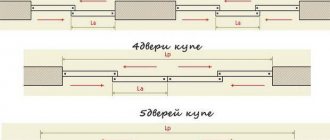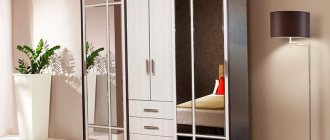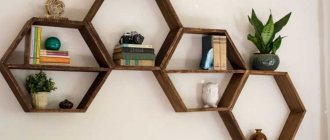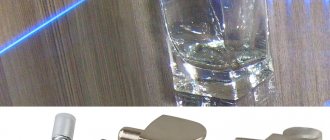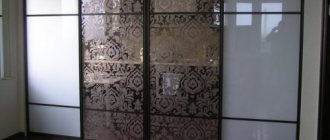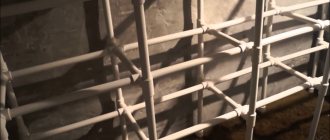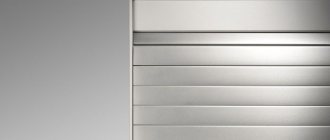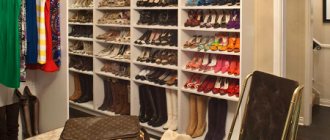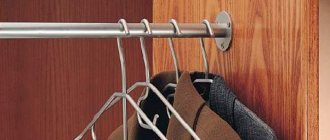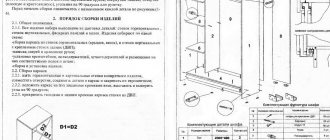4378 1 0
Vadim September 25, 2018
Whether it’s a chic wardrobe or an ordinary shelving unit, comfortable and durable shelves are considered an integral part of any such furniture. It would seem that it could be easier to install a horizontal plane, but there are now a lot of new holders on the market, and then we will analyze in detail all the main types of holders, and craftsmen will receive recommendations for installing shelf accessories with their own hands.
The choice of holder depends on the material from which the shelf is made, the dimensions of the shelf and the design load on the structure.
Types of fastenings
Manufacturers of furniture fittings offer various types of fasteners for shelves. Each of them corresponds to a specific installation method inside the cabinet. We will not consider fittings for pull-out shelves and rotating structures, but will focus on classic stationary options.
The most famous and common elements of such fastenings are:
- Euroscrew (confirmed).
- Rastex (minifix).
- Rafix.
- Shelf support.
- Dowel.
- Corners.
Brackets are also reliable supports for shelves, but they are not used in furniture production due to their bulkiness and unaesthetic appearance.
Euroscrew
Euroscrew or confirmat is used to connect chipboard parts to each other. Its length is 50 mm, diameter 6.4 mm. Holes for confirmations are made with a special countersink drill. Its length and diameter are equal to the dimensions of the Euroscrew.
The drill is slightly narrower than a European screw. When screwed in with a hexagonal driver, the confirmation spiral firmly cuts into the chipboard, forming a rigid and reliable connection between the shelf and the cabinet wall. The countersink at the upper end of the drill has a reaming collar, which flares the entrance hole under the countersunk. Thanks to this, the confirmation cap does not protrude above the surface of the chipboard.
The disadvantages of fasteners include the following:
- the screw heads have to be covered with adhesive circles or plastic plugs, and this somewhat spoils the appearance of the cabinet;
- This type of fixation does not allow placing shelves with a partition on the same center line. Horizontal slabs can only be installed vertically.
Rastex
The eccentric coupler consists of an eccentric sleeve and a dowel-screw. Rastexes are otherwise called minifixes and allow you to secure a shelf without visible fasteners.
The figure shows the technology for installing rastex. The rotary sleeve clamps the head of the dowel-screw. To secure the shelves, bushings are inserted into the horizontal plane of the slab from below. The whole operation consists of several stages:
- The hole for the eccentric is drilled with a special cutter ø 15 mm at a distance of 34 mm from the edge of the part to the center of the bushing. The working depth is 13 mm.
- Insert the eccentric with the cutout inward.
- From the end side, a hole is drilled to the opening cut with a milling cutter.
- In the cabinet wall and partition, recesses are drilled for plastic bushings, which are hammered in with a rubber hammer.
- Then ø 5 mm dowels are screwed into them.
- The other end of the dowel is inserted into the channel, reaching the rotary sleeve.
- The screw head fits into the eccentric cutout. Using a screwdriver, turn the bushing clockwise until it is completely secured.
Conical coupler
The connection is similar to raster. In both cases, the rod is screwed into a plastic dowel installed in the cabinet wall, and a seat for the bushing is cut with a milling cutter. The difference between a conical coupler is that the rotary cylinder has a through hole, and a circular recess is made at the end of the rod.
The rod is inserted into the sleeve through the hole in the shelf. A conical screw is screwed in from above, which firmly fixes the rod. The result is a hidden and durable fastening of the shelf.
Screw tie
Such a fastening element is used for hidden extension of a shelf with an additional plane or for connecting shelves at the same level through a partition. The fastener consists of two semicircular brackets, through the holes of which a screw with a hex nut is passed.
The connection is installed as follows:
- a cutter is used to cut out recesses in two shelves;
- A channel is made between the holes using a hand router. You can do this with a drill, drilling several holes and connecting them with a chisel;
- The staples are placed in the recesses and the rod is threaded through them.
- tighten the nut at the end of the screw.
- The connection in the flange is strengthened by installing dowels at the ends of the elements.
There are other types of screw ties. They are designed to connect the vertical walls of furniture to each other (pedestals and hanging cabinets in kitchen units).
Rafix
The screed has a second name - VB. Rafix is a plastic or metal sleeve with a dowel-screw.
Instructions for installing rafixes:
- In a shelf 18 mm thick, using a cutter ø 20 mm and height 14 mm, a recess is cut at a distance of 9.5 mm from the edge of the panel to the center of the recess.
- The bushing is driven into the hole with a rubber hammer or mallet.
- A hole for a ø 5 mm dowel is drilled in the cabinet wall or partition. Then screw the dowel screw under the Rafix tie.
- The shelf is placed on 4 dowels, which are tightened with a screwdriver or a screwdriver with a cross-shaped bit.
- the ties must be duplicated by installing dowels;
- fasteners have to be tightened at an angle, which creates certain inconveniences when installing shelves;
- The rafixes remain open, and in some cases they have to be covered with adhesive tape.
DIY rack
In order to properly design shelving for a dressing room, it is necessary to depict on the drawing all the necessary dimensions of the future structure, including shelves. After this, you need to decide on the construction material from which it will be made. Wood is mainly used, as working with it is quick and easy.
After the main frame is ready, you need to decide on the shelves. You can make shelves for your dressing room with your own hands or purchase ready-made ones. But the first option is preferable and more economical.
When making a shelf for a dressing room, you can use the following materials:
Most often, laminated chipboard is used for shelves, since the product is attractive, the load is high, and the price is more than affordable.
It is also important to know what to make shelves in the dressing room from. When choosing a material, you should take into account the following criteria:
- It is better to choose a Christmas tree or pine.
- The board must be well dried, otherwise deformation may occur.
- The board may be planed or not.
- The material can be either “Extra” class or second class.
If desired, you can choose any other material for making shelves, but wood is considered the most suitable, and there are no problems when working with it.
Shelves can be retractable or stationary. The width of such shelves cannot be less than 30 cm, so it is worth taking this detail into account when making shelves.
Don't forget about such important elements as wardrobe drawers, which are convenient for storing small items. Drawers can also protect underwear and bed linen from dust, so they should be in every wardrobe. Flat drawers and shelves can be divided into sections to store decorations and other small items.
Many people wonder how to make shelves in a dressing room with their own hands. To make a shelf to your liking. The following tools will be required:
- Construction pencil.
- Hammer.
- Roulette.
- Corners or other fastenings for shelves.
- Varnish coating or any other protective liquid.
- Brush.
- Jigsaw.
- Coarse and fine sandpaper.
On the prepared board you need to draw out the required dimensions and then cut out the shelf. You can also use a pattern, especially if you are making curly shelves. After this, place the board on a flat surface and cut out the shelf.
The cut part must be treated first with coarse and then fine sandpaper so that it is smooth.
If an unplaned board is used for shelves, it is necessary to sand it completely and remove all knots, and cover the recesses with putty.
Next, coat the shelf with varnish or another coating, and then leave it until dry. After drying, apply a second coat. When the shelf is dry, it can be attached to the rack.
Fastening shelves in a closet made of different materials
The majority of cabinets are made of laminated chipboard. A separate group includes models made of solid wood and MDF, as well as built-in cabinets with shelves made of plasterboard, furniture panels, plywood and other sheet materials.
In the future, we will start from the fact that both the body and the shelves of the cabinet are made of the same material - chipboard, MDF, plywood, solid wood with a thickness of 12-20 mm. Here we will consider the remaining, “non-standard” cases.
Fastening glass shelves
Fastening a glass shelf involves drilling the sides of the cabinet for shelf holders of various types. They can be “barrels” in a silicone shell, corners with a suction cup in the simplest version, or varieties of “pelicans” or “toucans” with a girth around the end of the shelf.
If the cabinet body itself is also made of glass, then UV gluing can be used for fastening. Also in the range of accessories for glass shelves you can choose special holders with through fastening. In this case, it is necessary to clarify the diameter of the holes for drilling (as a rule, fasteners are designed for installation in 5 or 8 mm holes).
Fastening mesh shelves
Mounting a metal mesh cabinet shelf is usually included in the kit. The shelf itself is sawn off to fit the internal size of the niche for installation; special holders are installed on the longitudinal rods on each side.
If a hanging rod or a support for inclined mounting is required (if it is a shelf for shoes), then the corresponding accessories are also purchased separately.
The metal shelf can be retractable. The draw-out mechanism is attached to the sides of the cabinet using regular 3x16 or 4x16 self-tapping screws. When installing, we recommend using the installation instructions - depending on the manufacturer, there may be nuances regarding the marking of reference points.
Built-in wardrobe: attaching shelves to walls
When installing built-in wardrobes, plastic corners of the “commander” type and consoles are usually used.
If the sides of the built-in wardrobe are made in the form of plasterboard partitions and it is not known where the mortgages are located, then it is better to use timber to support the shelves. A point connection will not be very reliable.
If necessary, attach heavy shelves or a mezzanine cabinet to loose walls. The beam will serve as a reliable support.
Options for ready-made shelving
- One-piece. These designs include cabinets with sections for outerwear, things, shoes and shelves for accessories. These also include fabric systems, which consist of a metal frame and a fabric cover. Such systems can also be equipped with shelves for storing various clothes and accessories.
- Modular are the most popular and convenient systems. The rack consists of vertical racks and various drawers and shelves are mounted on them. The size of the modular shelving depends on the size of the dressing room. This option is also more popular because it can easily be made larger or smaller, and is also easy to install and maintain.
- Cabinet structures are modules for arranging a dressing room, consisting of several sections. Sections can be placed close to each other or separately.
- Frame structures. They are a device made of metal racks. Their advantage is ease of assembly, good ventilation of things and the ability to rearrange components. For this design, you can select absolutely any shelves, not only made of metal, but also made of wood.
Through fasteners (with drilling) for confirmations
Confirmats are the most common through fasteners for shelves. To install, you will need to drill a hole in the end of the shelf with a diameter of 5 mm and on the front side of the side of the cabinet with a drill with a diameter of 8 mm. It is better to use a special confirmation drill. Since a countersink is still required for the head, the screw itself is flush with the surface of the sidewall. Next, the cap is hidden with a special self-adhesive plug, matched to the color of the chipboard.
A nuance: depending on the thickness of the sidewalls, the length of the confirmat is selected. For standard chipboard and MDF thicknesses of 16-18 mm, a 5x50 euroscrew is used; for thicker board materials, a longer one is used, up to 70 mm.
- Among the advantages of attaching shelves to confirmations, it is worth highlighting the ease of assembly and the low cost of the fasteners themselves.
- The downside is the need to drill through. Not everyone likes the “holey” sides of the cabinet from an aesthetic point of view. Although the self-adhesive plugs are color-matched, they are still visible. Also furniture assembled through repeated assembly and disassembly.
Pull-out shelves and trays with compartments for wardrobes
Not only metal baskets, drawers and other containers can be equipped with retractable mechanisms. Making simple shelves retractable is no less convenient and rational. But it is better to place them below your height, otherwise there is no point in pulling them out to make it easier to find the necessary items in the depths of the closet.
Pull-out shelves with compartments are convenient for storing socks, ties, jewelry, and other small accessories and hygiene items. Shelves in the form of hangers for trousers, skirts, scarves and other wardrobe items are also on sale.
Plastic pull-out shelves with recesses and sides lighten the weight of the structure, are easy to clean and prevent things from sliding off.
Hidden fastening of shelves in the closet
If the side of the cabinet remains visible and you want to maintain the integrity of the coating, then you can use hidden, invisible fasteners to install shelves.
Furniture dowels
The most affordable, but no longer as popular as before, is a furniture dowel. It can be made of solid wood and plastic. For better grip, the side surfaces of the dowels are made ribbed.
Why do furniture makers dislike fastening to dowels? Fasteners of this type are quite specific and require gluing. This means that additional clamps (clamps) are needed to fix the position and glue. And, of course, allotted time for the glue to dry. All this slows down the build.
Eccentric coupler
More modern hidden fasteners for shelves and tabletops are an eccentric (minifix) and a conical tie. This type of fastening requires a certain skill for installation and therefore a novice master may get a little stuck. You will have to drill several holes of different diameters for the sleeve and the dowel itself. Moreover, all of them must be performed strictly in the center relative to each other; moving left/right/sideways is unacceptable.
There are many varieties of eccentric couplers, but the principle is always the same. There is a dowel with a head and a sleeve that clings to the head. The sleeve can be rotated (as on minifixes and conical couplers), inserted and snapped into place.
Glass shelves
Due to their fragility, glass shelves are rarely used for internal filling of wardrobes in bedrooms, hallways, and children's rooms. But they are quite popular in the design of libraries with sliding doors and wardrobes in living rooms. They have two undeniable advantages:
But the very weight of the glass shelves is quite significant, which makes them fragile in terms of attachment to the side walls of the cabinet.
Corners for fastening shelves in a closet
Furniture corners, like fastening shelves for a closet, are not able to add rigidity to the body. Therefore, the internal filling must be combined with other types of rigid fasteners.
Conventional galvanized corners can be used in furniture assembly. But you should still choose fasteners among furniture fittings; they look more aesthetically pleasing. You can use plastic corners or those made of metal, with a plastic lid that snaps on top.
For deep and open shelves, various cantilever options are offered as fasteners. The design and color can be chosen at your discretion.
Shelving material
The material of the racks can be different:
- Metal. This material is considered the most correct solution. Firstly, metal wardrobe racks are the most practical and reliable. Secondly, they have a long service life.
- Tree. Wooden storage structures have an attractive appearance and reasonable cost, but require special attention when calculating the load and special care.
- Plastic. A rack made of this material will be durable and last forever; there are also many color options.
- Drywall. This material is easy to process, but it is not able to withstand heavy loads.
The owner himself chooses what material the rack will be made of, based on the wishes and characteristics of the design. But today, many people prefer to make wardrobe shelving with their own hands, since this is a more economical option and you can make exactly the shelving and fillings for it that you would like to see in your wardrobe.
How to attach removable shelves in a closet
If it is required that the shelf be removed and adjusted in height, stops are used for fastening - shelf holders. They are installed in holes with a diameter of 5 mm. Please note that the hole required is not through, unlike fasteners on confirmations (the diameter of the drill is the same).
The shelf holder can be not only “barrel” in shape, but also a “spatula”. For shelves that are narrow in depth, in which the shelf holders are located quite close to each other, there is a reason to use special shelf holders with fixation. They will “protect” the shelf from accidental tipping.
As with furniture corners, removable shelves do not add additional rigidity to the cabinet. Therefore, in high and wide sections they are alternated with those mounted on confirmats or eccentrics. Or they add additional stiffening ribs along the rear wall of the cabinet.
These are the main ways to attach shelves in cabinets. They are also used in other furniture for various purposes.
The main part of each cabinet is the shelves, thanks to which compact storage of various items is organized. A long and high-quality service life directly depends on the reliability and correct fastening of the shelves.
A long and high-quality service life directly depends on the reliability and correct fastening of the shelves.
Fixing the hanging shelves in the closet will not be difficult; you just need to make markings, observing the horizontal levels. Otherwise, the weight will be unevenly distributed over the surface of the shelf, and the load on one mount will be much greater than on the other. In the future, it will break and the shelf will fall, there is a possibility that the cabinet wall will ultimately be severely damaged.
The main part of each cabinet is the shelves, thanks to which compact storage of various items is organized.
Preparing shelves before installation
To make shelves well, you need to carry out preparatory measures. First you need to determine what is best to make the shelves in the closet from. The most common options are chipboard and identical materials. Chipboard is relatively economical and versatile in use. It is easy to work with: the slabs are perfectly sawn, which allows you to obtain workpieces with certain parameters.
We must not forget that such material is flexible. To prevent it from deforming from the weight of objects placed on the shelves, you need to take care of strengthening it. To give the workpieces the necessary rigidity, a narrow strip of wood should be secured to the upper (or lower) surface. Secure it along the back and front edges. Cut the workpiece to the desired size. For this purpose, it is recommended to use a saw (electric or circular).
If the edge looks unsightly, it is worth processing it so that things do not cling to it and do not deteriorate. Experts recommend using heat-adhesive tape specifically for working on the shelf. Its use allows you to give the product an aesthetic appearance. Just apply the tape to the edge and iron it with a heated iron.
Types of fastenings for cabinet shelves
The simplest option is self-tapping screws. They come with hidden caps and press washers.
Screws have a two-digit marking: the first number indicates the diameter of the thread, the second indicates the total length.
Screws have a two-digit marking: the first number indicates the diameter of the thread, the second indicates the total length. The higher the values of these parameters, the stronger the load on the screw can be.
To avoid cracks on the product, mounting holes should be made with a drill of a smaller thread diameter.
For installation, use a screwdriver or screwdriver. To avoid cracks on the product, mounting holes should be made with a drill of a smaller thread diameter.
Shelves made of chipboard and MDF
Among the advantages of simple blank shelves made of chipboard, MDF and other board materials, it is worth noting their strength. Traditional shelves can support significant weight. But at the same time, due to the fact that they themselves also weigh a lot, they can sag and sag. Therefore, for sliding wardrobes, it is recommended not to make the spans for shelves between partitions more than 700-800 mm.
Recommendations for the arrangement of chipboard shelves in a wardrobe
If the span is wider than 700 mm or a large load is planned on the chipboard shelf (for example, if tools, household appliances and other heavy objects are stored on it), it is better to strengthen the structure using stiffeners and additional partitions.
To avoid unfilled space with things, we recommend designing the interior with shelves more often than traditionally accepted:
- For shoes, it is better to make the distance between shelves about 200-250 mm.
- For linen and things that are at eye level, the optimal height between sections is 300-350 mm. The width of linen shelves should not exceed 500-600 mm.
- Wide niches with a height of 350 mm or more are appropriate for shelves above eye level. They are where large items are stored (blankets, pillows in the bedroom, bulky outerwear and sports equipment in the hallways, etc.)
Choosing accessories for fastening shelves
Shelves in bookcases and linen closets are mainly made of chipboard, but metal or glass can be used in kitchen units. Therefore, when choosing accessories for shelves, you should take into account the material from which they are made and the method of desired fastening.
You can choose a color that suits your furniture.
For shelves that will not be subjected to heavy loads, you can use any type of fittings.
Glass shelves should only be mounted on special overhead holders. Inside they are a rubber gasket that prevents deformation on the fragile glass surface. If there will be a large load on the shelves, it is better to use bracket holders.
Shelves in bookcases and linen closets are mainly made of chipboard, but metal or glass can be used in kitchen units.
Currently, the market offers a huge selection of various models of fastenings, retractable and rotating mechanisms, which are not difficult to install yourself. Choose only high-quality fittings - they will serve you faithfully for many years.
An eccentric coupler, or the so-called mini-fix, which consists of a rod, a fitting and an eccentric.
Shelf brackets: overview of the main shapes, designs and models of wall supports (80 photos)
Even in the largest apartment, rational storage organization makes life much easier for the owners. When utensils, furnishings, books and electrical appliances are in their place, they are very easy to find. But if there are a lot of things, then in addition to ordinary cabinets and cabinets, shelves will be a real salvation.
A correctly chosen shelf will decorate the interior and give it a complete look. It is worth taking care not only of the aesthetics of the product, but also of the technical parameters. Any shelf must be securely fixed to the wall and withstand the weight of the objects placed on it. All this is ensured by the selection of special fastening elements - brackets for the shelf.
Hanging corner
An old but effective way to attach any furniture to the wall
The system of fastening cabinets using a rigid corner with two holes for fastening to a cabinet and hanging has been known since old Soviet times.
Through holes are drilled along the edges of the frame, in the upper part of the cover, through them, using a bolt and nut, the corners are fixed flush with the back wall, they are hung on self-tapping screws screwed into the dowel. The mounting system is very reliable; it allows you to adjust only the height of the suspension.
Basic requirements for furniture
When determining how to properly hang cabinets in the kitchen, you must consider the following requirements:
- Cabinets should be located at a height that provides the most convenient access to dishes and kitchen utensils on the top shelf.
- Their location should not interfere with the ventilation system or spoil the aesthetic appearance of the kitchen with incorrect location geometry.
- The rigidity and reliability of the fastening must ensure long-term operation of the cabinets under high loads.
The main condition when installing hanging cabinets is to ensure accessibility to the top shelf. You can roughly set the height of the suspension in the following way: stand against the wall and raise your hands - at the point where your fingertips touch the wall, the top of the cabinet should be, in this case the shelves located below will be easily accessible.
Consider the height of hanging furniture based on your height, as well as the height of family members
There are also general recommendations for determining the height of the top shelf depending on height: if a person is 155 - 160 cm tall, it is 175 cm, if a person is 160 - 175 cm tall - the shelf height is 185 cm, if a person is 175 - 190 cm tall, the height is 175 cm installations 200 cm.
Depending on the furniture fittings, there are several ways to attach wall cabinets:
